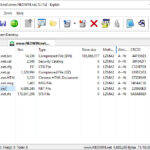DSEX Rises on Mid- and Small-Cap Gains as Blue-Chip DS30 Slips, Indicating Cautious Optimism
Dhaka’s stock market finished a mixed session on 20 February 2025, with the benchmark DSEX inching higher on gains across mid- and small-cap shares, even as blue-chip stocks weakened. The day underscored a cautious but constructive mood among investors, who chased value in the mid- and small-cap space while weighing the steadier but softer backdrop from heavyweight names. This tug-of-war produced a cautious but ultimately positive close for equities, supported by a notable uptick in turnover and a shift in attention toward undervalued stocks rather than merely chasing the largest names.
Market Overview and Index Movement
Dhaka Stock Exchange’s overall sentiment for the session pointed to a bifurcated performance pattern. The DSEX, the broad-based benchmark index, rose by 7.93 points, up 0.15%, and finished the day at 5,200. This incremental gain signaled resilience in the broader market driven by mid- and small-cap equities showcasing stronger price action than their larger-cap peers.
In contrast, the DS30 index—tracking blue-chip companies—slid by 3 points, a decline of 0.16%, reflecting a sell-off among heavyweight constituents. The divergence between the broader market’s gains and the blue-chip weakness captured the central tension of the session: investors buried their risk appetite in relatively cheaper or underappreciated names while trimming positions in higher-priced, top-tier stocks perceived as having run up too quickly.
The day’s structure saw a classic late-session rally pattern. Although the market opened on a positive note, initial optimism gave way to selling pressure that threatened to cap gains. However, buyers reasserted control in the final hours, producing a U-shaped recovery that propelled the benchmark back into positive territory after consecutive sessions of decline. This intraday resilience underscored a market that remains sensitive to intraday shifts in sentiment but willing to climb back as buying momentum returned.
Trading activity reflected renewed participation. Turnover rose by 9% to Tk466 crore, signaling heightened investor engagement and a willingness to deploy capital across a broader spectrum of stocks rather than concentrating exclusively on the most liquid blue chips. The turnover uptick also highlighted a confidence uplift among market participants that price levels were becoming attractive enough to warrant fresh allocations, particularly in stocks perceived as undervalued or presenting favorable risk-reward dynamics in the near term.
Analysts framed these movements as a reflection of evolving investor preferences in a climate of improving macro cues and liquidity conditions. A senior analyst at a leading brokerage emphasized that an increasing share of market participants, including institutional investors, were shifting funds toward equities in response to falling yields on government securities. The logic underpinning this shift rested on a few linked factors: treasury yields have trended lower since early February amid an abundance of liquidity in the banking system and softer demand for private sector loans, which in turn supports the case for higher equity valuations.
The same analyst noted that government security yields had dropped by nearly two percentage points since December, stabilizing at just over 10% in February according to official data. The interpretation offered was that when risk-free rates decline, the opportunity cost of holding equities diminishes, encouraging investors to seek higher returns inside the stock market. In turn, this dynamic can amplify demand for equities as investors reallocate funds from safer government instruments into higher-yielding equities.
Together, these factors painted a nuanced picture: while blue-chip stocks faced selling pressure, the broader market found strength in mid- and small-cap segments and in the appetite of institutional and other high-net-worth investors seeking higher potential returns in undervalued or overlooked stocks. The net effect was a market that, even in the face of a temporary pullback in heavyweight names, managed to sustain a constructive tone and increased liquidity.
Key statistics from the session highlighted the breadth of participation. The market breadth was positive, with 167 stocks advancing, 160 declining, and 74 remaining unchanged. This distribution underscored the presence of broad-based activity beyond a narrow band of leading issues, reinforcing the sense that a wider swath of the market was engaged in potential upside moves.
Within this framework, sectoral dynamics and stock-specific narratives mattered. While the article’s data did not specify sector-by-sector leaders beyond the mid- and small-cap strength, the narrative of profit-taking in high-value stocks and a renewed interest in undervalued segments pointed to a re-pricing trend where risk-reward was more favorable in the smaller, growth-focused names than in the most expensive blue chips. The market’s direction, shaped by these forces, suggested that investors were balancing short-term profit booking against longer-term positioning in a market still in the process of price discovery and reallocation of capital toward segments with perceived greater upside potential.
Key Takeaways
- DSEX rose by 7.93 points to 5,200, signaling a mild but positive broad-market move.
- DS30 fell by 3 points (0.16%), indicating ongoing pressure on heavyweight blue-chip stocks.
- Market breadth favored gains with 167 advances versus 160 declines and 74 unchanged.
- Turnover increased by 9% to Tk466 crore, signaling rising participation and liquidity.
- Analysts linked the shift in sentiment to falling government yields and a broader reallocation into equities, particularly among institutional players seeking higher returns as liquidity remains ample.
Mid-Cap and Small-Cap Leaders: The Rise of B-Category Stocks
A distinctive feature of the session was the outsized role played by B-category stocks, often defined as mid-level corporations typically offering a maximum dividend payout around 5%. These stocks dominated the top gainers’ list, underscoring a market tilt toward undervalued or under-appreciated names that investors perceived as having robust growth potential despite broader systemic headwinds in the blue-chip segment.
Within this category, several companies stood out for impressive price momentum and willingness of the market to reward price strength. Six companies, in particular, hit their upper circuit breakers, signaling maximum permissible intraday gains under the prevailing trading rules and highlighting the fervent demand for these names during the session. The day’s top gainers exhibit a clear pattern: strong price appreciation driven by optimism about underlying fundamentals, modest dividend expectations, and a favorable re-rating by investors who had marked these stocks as undervalued in recent corrections.
Key gainers included:
- Fu Wang Food, which surged by 10% and closed at Tk15.4.
- S Alam Cold Rolled Steels, also up 10%, closing at Tk15.4.
- Golden Harvest Agro Industries, rising 9.83% to Tk13.4.
- BD Thai Food, increasing 9.79% to Tk15.7.
- Shinepukur Ceramics, up 9.70% to Tk14.7.
- Zaheen Spinning, gaining 9.58% to Tk8.
These six names collectively illustrated the breadth of interest in the B-category space, with gains ranging from roughly 9.6% to 10% and six upper circuit hits signaling ceiling-bound enthusiasm within a single trading session. It is notable that such a strong performance among mid-tier and small-cap stocks occurred even as the blue-chip corridor softened, which reinforced the narrative of a market rotating toward value opportunities outside the heavyweight leaders.
The concentration of gains among mid- and small-cap stocks can be interpreted through several lenses. For one, investors may be seeking to capture upside in assets that previously traded at more conservative valuations, especially in a market environment where yields on traditional fixed-income instruments are declining, and liquidity remains abundant. Secondly, the presence of six upper-circuit stocks indicates a degree of speculative fever or at least intense appetite for momentum in names with favorable pricing dynamics, potential for margin expansion, or positive earnings signals not yet fully priced into the broader market.
From a portfolio-management perspective, the day’s activity underscored the importance of diversification within the equity landscape. While blue chips often provide stability and reliable dividends, mid-cap and small-cap segments carry higher growth potential—paired with more pronounced volatility. In an environment of falling government yields, risk-tolerant investors may tolerate additional volatility in pursuit of higher returns, a dynamic reflected in the day’s gains.
For market observers and participants, these gains among B-category stocks imply several implications. First, there is evidence of robust liquidity flows toward equities with compelling risk-reward dynamics, suggesting that investors are comfortable taking on slightly higher risk for higher upside. Second, the sectoral mix within the B-category—ranging from food and agro to steel and ceramics—highlights a broad-based appetite across different industries, which can contribute to more balanced upward pressure on the overall market indices when blue chips waver. Finally, the performance may foreshadow potential earnings catalysts or strategic shifts that investors expect in the near term, particularly if corrections and profit-taking have cooled sufficiently to allow for renewed upward momentum in select names.
Notable Aspects of the Gainers
- The fact that six top gainers hit their upper circuit breakers suggests a strong appetite for price discovery in the mid- and small-cap section.
- Price movements were substantial, with two names closing at Tk15.4 after a 10% surge, and other gainers showing notable gains in the 9.6%–9.9% range.
- The breadth of sectors represented among the gainers (from food to steel to ceramics) provides evidence that the market was not narrowly focused on a single industry, but rather pursuing a broader set of undervalued opportunities.
In sum, the session illustrated a clear rotation dynamic across the Dhaka market: while heavyweight stocks faced selling pressure, mid- and small-cap equities attracted renewed capital allocation, reshaping the day’s mood into a constructive, albeit cautious, risk-on posture. The market’s willingness to reward B-category stocks and to lift several of them to upper circuit levels signaled a crucial shift in investor confidence and a potential catalyst for continued upside in the near term, particularly if macro conditions such as liquidity and yields evolve in a favorable direction.
Investor Sentiment, Macro Backdrop, and the Liquidity Environment
A central thread weaving through the session was the macro backdrop shaped by government securities yields and the liquidity available in the banking system. Analysts and market observers highlighted that a rise in the attractiveness of equities is closely tied to a falling trend in government borrowing costs and the broader liquidity conditions that can drive capital toward risk assets.
The commentary from market observers emphasized that falling yields on government securities—driven by surplus liquidity in banks and subdued private-sector loan demand—made equities comparatively more appealing. The prospect of lower lending rates, coupled with relatively higher expected returns from stocks, encouraged a reallocation of funds away from fixed-income assets toward equities. This shift in allocation can support stock valuations and generate a more favorable environment for price appreciation in risk assets.
Bangladesh Bank data indicated that government security yields have declined by nearly two percentage points since December, landing at just over 10% in February. This trend played a significant role in shaping investor expectations, as lower yields typically reduce the relative attractiveness of bonds and make equities an alternative source of yield and growth. In such conditions, market participants often anticipate a continued search for higher returns, which can extend the momentum in the stock market even if macro fundamentals show mixed signals.
The market’s reaction to this macro backdrop was nuanced. On one hand, the fall in yields supports a constructive risk-on environment, particularly for mid- and small-cap stocks that can offer sharper growth trajectories. On the other hand, the divergence between DSEX and DS30 points to a selective appetite, where investors prefer to diversify exposure away from high-priced blue chips toward segments with potentially larger upside, albeit with higher volatility.
The analyst’s view underscored a widely observed phenomenon: when interest rates are falling, capital tends to flow toward equities as investors seek higher returns, and this dynamic can feed a favorable cycle of buying pressure and price appreciation. It is important to note that such a trend does not guarantee sustained gains; it requires continued liquidity, a stable macro backdrop, and ongoing earnings potential among the stocks being bought. The session’s outcomes suggested that, at least in the near term, investors believed undervalued mid- and small-cap stocks could offer superior upside as the market priced in upcoming earnings and growth potential.
This macro narrative also aligns with broader market dynamics often seen in emerging-market exchanges: a move away from the safety of fixed income when yields are depressed, toward the growth potential offered by equities. While the blue-chip segment may face periodic re-pricing or profit-taking, the broader market gains observed in the session signal the market’s capacity to absorb such adjustments and continue to find pockets of value, particularly among stocks that have not yet realized their full upside.
Key Takeaways on the Macro Backdrop
- Government security yields have fallen by about two percentage points since December, moving to just over 10% in February.
- The decline in yields, together with excess liquidity in the banking sector, supports a shift of funds toward equities, particularly in undervalued mid- and small-cap stocks.
- A growing number of institutional investors are reallocating toward the stock market as treasury yields ease, reinforcing the potential for continued upside momentum.
- The divergence between DSEX and DS30 underscores a market with selective risk appetite, favoring growth-oriented, undervalued segments rather than a uniform rally across all blue chips.
Turnover, Participation, and Market Psychology
Beyond the directional signals from the indices, the day’s turnover data points to a more active and engaged market. The 9% rise in turnover to Tk466 crore indicates that investors were not simply trading in a narrow set of liquid names but participating across a broader spectrum. Increased activity often accompanies a combination of renewed confidence, trading opportunities, and the presence of speculative interest in stocks believed to be mispriced or undervalued.
Brokerage commentary highlighted a shift in investor composition, with institutional players increasingly directing funds toward the stock market. This shift is consistent with a broader theme in which surging liquidity and lower relative risk-free rates incent institutions to seek higher-yielding assets in equities, thereby driving higher volumes and potentially contributing to price discovery in mid- and small-cap segments.
In the same breath, market observers noted that the day’s gains in mid- and small-cap stocks came after a period of short-term profit booking in some high-value names. The market’s reopening and subsequent intraday momentum suggest that some investors sought to rebalance portfolios, taking advantage of price corrections in heavyweight stocks to position for a subsequent leg higher in select equities.
From a psychology standpoint, the session portrayed a market navigating between two impulses: discipline and opportunity. Investors weighed the downside risk of a blue-chip correction against the upside potential of undervalued names that might gain from ongoing liquidity and improving macro indicators. The final hour’s rally signaled that the buying side had regained conviction, reinforcing a narrative in which the market can sustain modest gains even amid some sector-specific weakness.
Practical Takeaways for Investors
- Turnover growth to Tk466 crore reflects rising participation and liquidity, reinforcing the signal of an active market environment.
- Institutional investors’ shifting capital toward equities suggests confidence in the market’s capacity to deliver returns in a lower-rate regime.
- Profit-taking in blue chips created buying opportunities in mid- and small-cap stocks, particularly among those with solid fundamentals and potential for price appreciation.
- The market’s ability to stage a U-shaped recovery after an initial dip demonstrates resilience and a willingness among buyers to re-enter at favorable levels.
Stock and Sector Highlights: Blue-Chip Pressure and Gainers in Focus
The session’s distinctive feature was the clear split between the performance of blue chips and mid-/small-cap stocks. While the blue-chip segment faced selling pressure, the mid- and small-cap domain emerged as a focal point of strength, aided by a cluster of gainers that underscored the market’s appetite for undervalued names with visible upside.
In particular, B-category stocks dominated the top gainers’ chart, reflecting a broader appetite for mid-level equities and corroborating the thesis of investors seeking opportunities beyond the most expensive names. The six upper-circuit gainers—Fu Wang Food, S Alam Cold Rolled Steels, Golden Harvest Agro Industries, BD Thai Food, Shinepukur Ceramics, and Zaheen Spinning—were the highlights of the trading session, illustrating how broader market rotations can elevate specific stocks that are perceived to have significant catch-up potential.
Closing snapshots for these top gainers showed:
- Fu Wang Food: up 10% to Tk15.4
- S Alam Cold Rolled Steels: up 10% to Tk15.4
- Golden Harvest Agro Industries: up 9.83% to Tk13.4
- BD Thai Food: up 9.79% to Tk15.7
- Shinepukur Ceramics: up 9.70% to Tk14.7
- Zaheen Spinning: up 9.58% to Tk8
The presence of six stocks hitting their upper circuit not only signaled strong momentum but also highlighted the breadth of enthusiasm across several categories of the mid- and small-cap space. It’s notable that these gains occurred in a context where the broader market’s blue-chip leaders faced pressure, suggesting that investors were actively seeking value and momentum well beyond the most familiar names.
From a sectoral perspective, these gains illustrate a diversified appetite across industries—including food, metal, agro, and ceramics—reinforcing the notion that investors were differentiating opportunities on fundamentals rather than chasing a single sector’s rally. The day’s stock-specific performance provided a practical example of how a rotating market can reward quality stories across a range of industries when valuations are reasonable and earnings potential is compelling.
Implications for Market Strategy
- The concentration of strength in B-category stocks implies that investors should monitor mid- and small-cap segments closely, especially those with strong earnings trajectories or favorable margins.
- Upper circuit moves can attract momentum traders but also raise caution about potential volatility and the sustainability of such surges. Investors should weigh fundamentals, liquidity, and earnings outlook when selecting candidates.
- The absence of a uniform rise across all blue chips reinforces the importance of stock-specific analysis, even when macro conditions remain supportive for equities.
Conclusion
The 20 February 2025 session at the Dhaka Stock Exchange demonstrated a nuanced market landscape characterized by a modest uptick in the broad market index (DSEX) despite a pullback in blue chips (DS30), a marked rotation toward mid- and small-cap stocks, and a notable uptick in turnover that signaled improved participation. The divergence between DSEX and DS30 captured the core tension of the day: investors rewarded undervalued or undervalued-looking mid-cap opportunities amidst a backdrop of profit-taking in heavyweight stocks.
A key driver of this environment was the macro backdrop, with government security yields trending downward and liquidity remaining ample in the banking sector. As yields declined from December levels to just over 10% in February, investors continued to reassess risk and return, favoring equities with the potential for higher returns. The market’s behavior—marked by a robust push in B-category gainers, a dozen or more stocks showing gains, and several upper-circuit closes—suggests a market currently comfortable with risk and confident in selective upside across a diversified set of stocks.
Looking ahead, the ongoing dynamic will likely hinge on several factors: the pace of liquidity in the banking system, evolving expectations for government borrowing costs, and the degree to which institutional investors maintain or expand their exposure to equities amid a varying rate environment. If mid- and small-cap gainers can sustain momentum and blue chips stabilize after further corrections, the Dhaka market could look toward a broader recovery with renewed confidence among investors.
In summary, the session reinforced the Dhaka market’s dual character: a resilient broad market with an undercurrent of risk-on appetite among investors who are increasingly focused on value, growth potential, and fundamentals beyond the largest names. The strong turnover, the breadth of gains among mid- and small-cap stocks, and the strategic positioning by institutional players point toward a market that remains receptive to value-driven opportunities, even as it navigates the complexities of a shifting macro backdrop and evolving investor sentiment.



